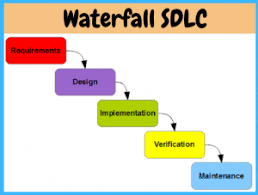The Waterfall Model in Software Development Life Cycle (SDLC)
The Waterfall model is a traditional approach to software development that follows a linear and sequential process. It is one of the oldest and most widely used models in the industry. The model is called “Waterfall” because progress flows in a downward direction, like a waterfall, through several phases.
The different phases of the Waterfall model include:
- Requirements Analysis: Gathering and documenting requirements from stakeholders.
- System Design: Creating a high-level design of the system based on requirements.
- Implementation: Developing the software based on the design specifications.
- Testing: Verifying that the software meets the specified requirements.
- Maintenance: Making updates and improvements to the software as needed.
One of the key features of the Waterfall model is that each phase must be completed before moving on to the next phase. This sequential approach ensures that requirements are well-defined before implementation begins, reducing the risk of changes later in the process.
While the Waterfall model has its advantages, such as clear documentation and well-defined milestones, it also has some drawbacks. One notable drawback is that it can be inflexible when it comes to accommodating changes during development. Once a phase is completed, it can be difficult and costly to go back and make changes.
Despite its limitations, many organizations still use the Waterfall model for projects with well-understood requirements and where changes are unlikely. It remains a popular choice for industries such as aerospace, defense, and government projects where strict control over requirements is essential.
In conclusion, the Waterfall model is a structured approach to software development that emphasizes clear documentation and sequential progress through defined phases. While it may not be suitable for all projects, it continues to be a valuable tool in certain industries where predictability and control are paramount.
Understanding the Waterfall Model: Key Questions and Insights for Software Development
- What is the Waterfall model in software development?
- What are the different phases of the Waterfall model?
- How does the Waterfall model differ from other software development models?
- What are the advantages of using the Waterfall model in SDLC?
- What are the disadvantages of using the Waterfall model in SDLC?
- When is it appropriate to use the Waterfall model in a software development project?
- Are there any variations or adaptations of the traditional Waterfall model?
What is the Waterfall model in software development?
The Waterfall model in software development is a traditional and linear approach that follows a sequential process with distinct phases. In the Waterfall model, progress flows downward through stages such as requirements analysis, system design, implementation, testing, and maintenance. Each phase must be completed before moving on to the next, ensuring a structured and systematic development process. While the Waterfall model offers clear documentation and well-defined milestones, its rigidity can make it challenging to accommodate changes once a phase is completed. Despite its limitations, the Waterfall model remains a popular choice for projects with well-understood requirements and in industries where strict control over specifications is crucial.
What are the different phases of the Waterfall model?
The Waterfall model in software development follows a structured approach with distinct phases that must be completed sequentially. The different phases of the Waterfall model include Requirements Analysis, System Design, Implementation, Testing, and Maintenance. In the Requirements Analysis phase, stakeholders’ requirements are gathered and documented. The System Design phase involves creating a high-level design based on the requirements. Implementation is where the software is developed according to the design specifications. Testing verifies that the software meets the specified requirements. Finally, in the Maintenance phase, updates and improvements are made to the software as needed. Each phase builds upon the previous one, emphasizing clear documentation and well-defined milestones throughout the development process.
How does the Waterfall model differ from other software development models?
The Waterfall model differs from other software development models primarily in its sequential and linear approach to the development process. Unlike iterative or agile models that allow for flexibility and adaptation throughout the project, the Waterfall model follows a strict progression through defined phases, with each phase dependent on the completion of the previous one. This rigid structure can be both a strength and a limitation, as it ensures clear documentation and well-defined milestones but can also make it challenging to accommodate changes once a phase is completed. In contrast, other models like Agile prioritize collaboration, adaptability, and continuous feedback to deliver incremental improvements and respond to evolving requirements more effectively.
What are the advantages of using the Waterfall model in SDLC?
One of the frequently asked questions about the Waterfall model in Software Development Life Cycle (SDLC) is regarding its advantages. The Waterfall model offers several benefits, including clear documentation at each phase, well-defined milestones for progress tracking, and a structured approach that ensures requirements are thoroughly analyzed before moving on to implementation. Additionally, the linear and sequential nature of the Waterfall model provides a systematic way to manage projects with predictable outcomes, making it suitable for projects with stable requirements and where changes are minimal or unlikely.
What are the disadvantages of using the Waterfall model in SDLC?
One of the most frequently asked questions regarding the Waterfall model in Software Development Life Cycle (SDLC) is about its disadvantages. While the Waterfall model offers clear documentation and well-defined milestones, it also has limitations that need to be considered. One major disadvantage is its lack of flexibility when it comes to accommodating changes during the development process. Once a phase is completed, it can be challenging and costly to go back and make modifications. This rigidity can lead to potential delays and increased project costs if requirements change or new insights emerge later in the development cycle. Additionally, the sequential nature of the Waterfall model may not be suitable for projects with evolving or unclear requirements, as it requires all requirements to be defined upfront before moving forward with implementation.
When is it appropriate to use the Waterfall model in a software development project?
When considering when to use the Waterfall model in a software development project, it is important to assess the project’s requirements and constraints. The Waterfall model is most suitable for projects with well-defined and stable requirements, where changes are unlikely to occur once the project has started. It is also ideal for projects that have a clear and linear progression from one phase to the next, without the need for frequent iterations or feedback loops. Industries such as aerospace, defense, and government projects often benefit from the Waterfall model due to their strict regulatory requirements and emphasis on documentation and predictability. However, it may not be suitable for projects where requirements are likely to change or evolve during development, as the model’s sequential nature can make it challenging to accommodate changes once a phase has been completed.
Are there any variations or adaptations of the traditional Waterfall model?
Yes, there are variations and adaptations of the traditional Waterfall model that have been developed to address some of its limitations. One common variation is the V-Model, which emphasizes testing at each stage of the development process to ensure that requirements are met before moving on to the next phase. Another adaptation is the Iterative Waterfall model, which allows for iteration and feedback between phases to accommodate changes more effectively. Additionally, the Spiral model combines elements of both Waterfall and iterative development by incorporating risk analysis and prototyping throughout the process. These variations offer more flexibility and adaptability compared to the strict linear progression of the traditional Waterfall model.



